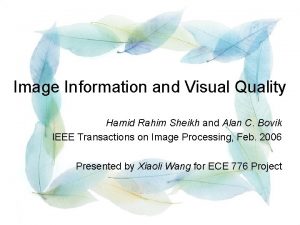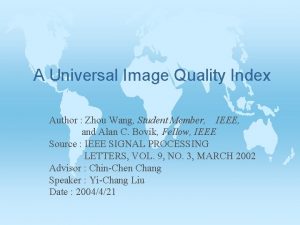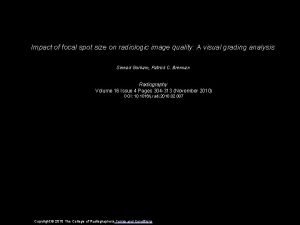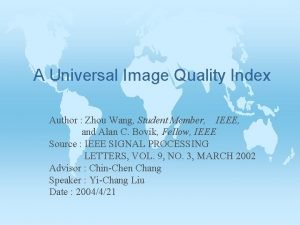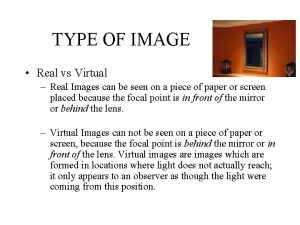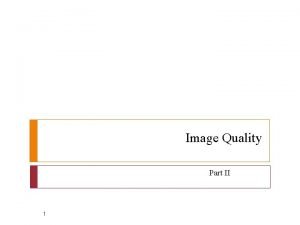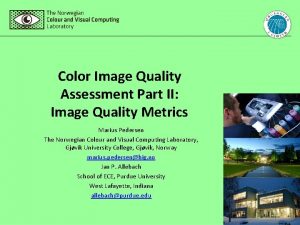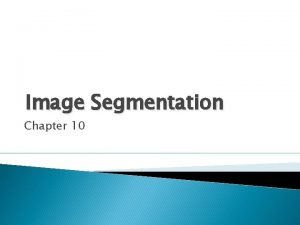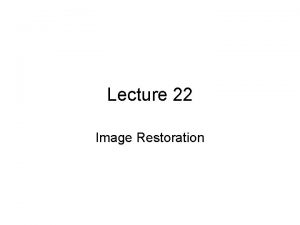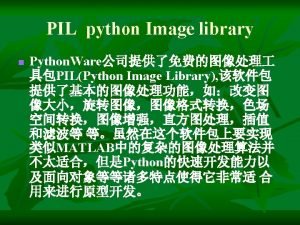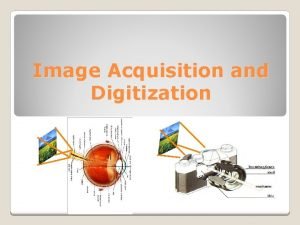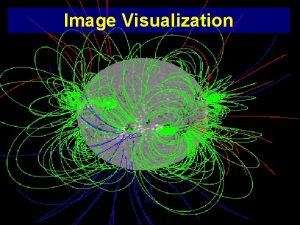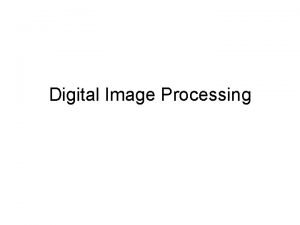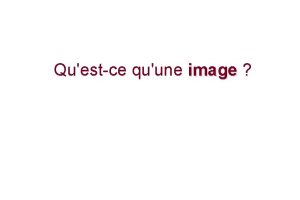1 CHAPTER 11 IMAGE QUALITY 2 Image quality






















- Slides: 22

1 CHAPTER 11 IMAGE QUALITY

2 Image quality is a combination of many interrelated factors: Axial resolution Lateral resolution Sharpness Contrast resolution Artifacts Geometric distortion Noise Temporal resolution

Axial resolution 3 Axial resolution is determined by the spatial pulse length, frequency, and the bandwidth of transducer. High frequency and broad bandwidth produce short transmission pulses, and the resultant short echo pulses can be faithfully converted into radiofrequency signals (good axial resolution).

Axial resolution 4 The finite spatial pulse length limit the axial resolution. By increasing transducer frequency or minimizing ringing, it is possible to shorten the spatial pulse length and improve axial resolution. Resolution is about ½ pulse length Typical axial resolution of modern ultrasound systems is 0. 5 to 2 mm.

Pulse shaping 5 A, Exponentia l pulse. B, Gaussian pulse.

Lateral resolution 6 Lateral resolution is improved by increasing the transmitted frequency, aperture, scan line density and by focusing the beam. The line density is controlled by the number of line per frame, the width of FOV, and the scan format. Unlike axial resolution that remains fairly constant with depth, the lateral resolution, which depends on beam width, changes with depth.

Sharpness 7 Sharpness describes the ability of the scanner to reproduce tissue boundaries and, is closely related to spatial resolution.

Contrast resolution 8 Contrast resolution is the minimum difference in signal strengths from adjacent structure that allows the observer to perceive the structures as separate entities.

Contrast resolution 9 Mathematically, image contrast is calculated by: C = Bt – Bb/0. 5 (Bt + Bb) Bt is the target brightness, Bb is the background brightness.

Contrast resolution 10 Image contrast is composed of two components, intrinsic contrast and displayed contrast. Intrinsic contrast originates from physical differences between the detected interfaces, acquisition parameters and processing. Displayed contrast translates pixel values to brightness levels on the monitor via the grayscale map.

Scan sequence 11 Electronic steering allows the scan lines to be acquired in any order. Lines in the black are obtained first, and then the lines in gray across the field of view. Interline interference is reduced by separating sequential scan lines.

Partial volume 12 The finite beam width can create a partial volume artifact related to slice thickness.

Partial volume 13 A, a large beam width extends beyond the boundary of the cyst, allowing echoes from surrounding tissue to contribute to the scan line. B, reducing the beam width limits the sampling to the cyst through the central portion of the cyst. C, when sampling occurs at the edge of the cyst, a narrow beam may include echoes from surrounding tissue. A B C

Noise 14 Spurious signals, which do not correspond to the echoinduced signal, are generally classified as noise. The variation in signal level contributed by noise causes brightness fluctuations in the image. Noise originated both from electrical and acoustical sources Noise can be reduced by reject control, frame averaging and adaptive frame averaging Clutter and speckle are types of acoustic noise

Clutter 15 Clutter is spurious signals arising from echoes induced by ultrasound transmission outside the main beam. Side lobes and grating lobes contribute to clutter. Tissue harmonic imaging can reduce clutter

Speckle 16 Numerous, small scattering centers within the volume of tissue interrogated by the ultrasound beam produce multiple scattered echoes over a wide range of angles. The bright and dark variations in the image are responsible for the name speckle.

Speckle 17 Small reflectors in the beam scatter ultrasonic energy. Some of the energy is redirected toward the transducer by additional scatters located

Speckle 18 Frequency dependence of speckle pattern. Sonograms of a tissuemimicking phantom with a stimulated mass and cyst obtained with a frequency of A, 4 MHz

Artifacts 19 Artifacts are structures in the image that do not represent, with fidelity, the objects within the field of view. An artifact is any structure in the image that does not correlate directly with actual tissue. Miscalibration, improperation of equipment play roles in artifact production

Geometric distortion 20 Geometric distortion is a parameter describing the lack of adherence to original spatial relationships. Inaccurate presentation of spatial relationships is called geometric distortion Spatial mapping of the echoes depends on the line density, beam width, number of sampling points, …

Temporal resolution 21 Temporal resolution refers to the ability to accurately observe moving along the path of motion. Line density, scan range and frame rate are inter-related and effect of temporal resolution

Tissue characterization It is the identification of tissue type The goal is to obtain specific pathologic diagnostic Tissue characterization methods are: Sonogram pattern recognition Signal processing o the received signal Static of the image data
 Quality control and quality assurance
Quality control and quality assurance Plan quality management pmp
Plan quality management pmp What are quality standards in project management
What are quality standards in project management Ana quality assurance model
Ana quality assurance model Quality improvement vs quality assurance
Quality improvement vs quality assurance Basic concept of quality management
Basic concept of quality management Two quality gurus
Two quality gurus Quality is free
Quality is free What is tqm
What is tqm The listening gap
The listening gap Upgrade image quality
Upgrade image quality Hamid rahim
Hamid rahim Universal image quality index
Universal image quality index Contoh pelembutan citra
Contoh pelembutan citra Oid radiography
Oid radiography Radi
Radi Factors affecting ct image quality
Factors affecting ct image quality A universal image quality index
A universal image quality index Real image vs virtual image
Real image vs virtual image Real vs virtual images
Real vs virtual images Translate
Translate Optimum notch filter in image processing
Optimum notch filter in image processing Image compression in digital image processing
Image compression in digital image processing











